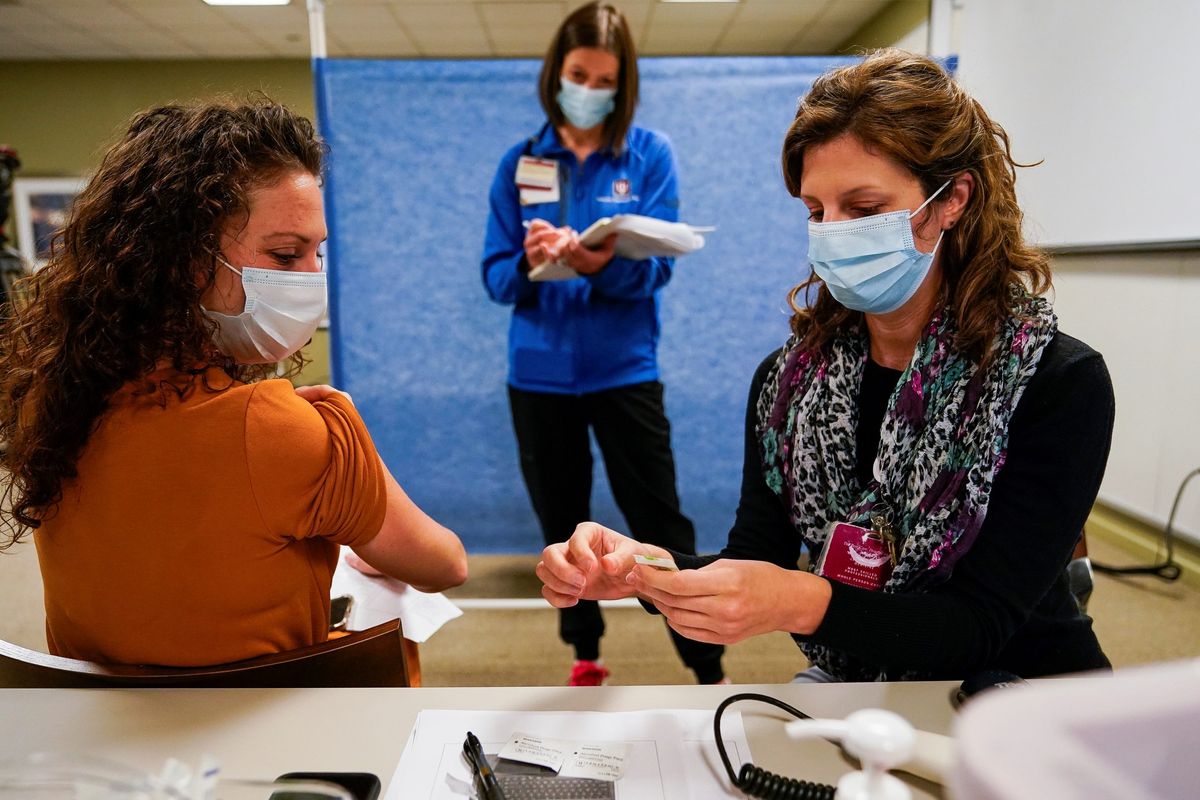The coronavirus vaccine is the first approved use of mRNA vaccines by the FDA. Here’s how it works

A few minutes every morning is all you need.
Stay up to date on the world's Headlines and Human Stories. It's fun, it's factual, it's fluff-free.
Pharmaceutical companies Moderna and Pfizer/BioNTech have introduced a novel type of vaccine made from messenger RNA, known as mRNA.
As COVID-19 cases worldwide surpass 72 million, news of a vaccine has come as a light at the end of the dark tunnel that has been 2020. However, for many analysts, the coronavirus vaccine has raised questions about the future of vaccinations.
Traditionally, vaccines contain either weakened or dead forms of a microorganism, its toxins, or purified signature proteins of a virus. The introduction of this weakened or dead virus allows the body to recognize it as a threat and develop immunity to protect itself against it.
But the pharmaceutical companies Moderna and Pfizer/BioNTech have introduced a novel type of vaccine made from messenger RNA, known as mRNA.
Since money for a vaccine was quickly allocated, the companies were able to fast-track the rigorous testing needed to meet trial standards in a much quicker time-frame. The vaccine has since been tested on 43,500 people in six countries.
The trials surprised scientists by revealing around 95% efficacy. For reference, the World Health Organization (WHO) requires only 50% efficacy for a viable COVID-19 vaccine.
When a patient is injected with the mRNA vaccine, it directs the patient’s cells to create coronavirus spike protein and, in turn, triggers the immune system to produce antibodies and activate T-cells to respond to an infection.
If the patient then comes into contact with COVID-19, these antibodies and T-cells are automatically activated to fight the virus. What’s more, no actual virus is present in the mRNA vaccine. This dramatically increases the rate and cost-efficiency at which the vaccine can be produced.
This novel vaccine mimics how the coronavirus reacts inside the body, but codes only for the key fragment of the viral protein.
Unfortunately, while this synthetic mRNA is genetic material, it cannot be transmitted to the next generation and requires two doses to maintain efficacy.
Still, analysts are cautiously optimistic that this will be a safer option than a traditional vaccine, particularly for the elderly, who often have weakened immune systems.
Moderna alleges that during the third phase of its study, just 95 COVID-19 cases occurred, of which 90 presented in the placebo group and only 5 in the vaccinated group. That out of a participant study group of around 30,000 adults.
It’s also important to note that none of the infected patients who received the vaccine displayed severe symptoms, while 11 (12%) of those who received the placebo did.
How does this compare to the seasonal flu vaccine?
“Current knowledge about the coronavirus indicates this virus doesn’t act like the flu virus, meaning the existing vaccines should work effectively against [any strain of] CoV-2 around the globe,” Dr. Jeffrey Ebersole, Interim Chair of Biomedical Sciences & Associate Dean for Research at the University of Nevada, Las Vegas, told TMS.
For the seasonal flu, it takes scientists approximately six months to identify the strain of influenza and to manufacture a vaccine.
To do so, researchers grow a candidate flu vaccine in hens’ eggs, in order to design a hybrid virus that is less dangerous. They then inject this hybrid virus into fertilized eggs and incubate the virus for a number of days to create duplicates.
Scientists then harvest the fluid bearing the eggs, killing any viruses within the vaccine, and purify the viral proteins over several days.
Alternatively, the mRNA vaccines require a much less complex manufacturing process as they do not contain any elements of the viral proteins. Rather, the vaccine acts as a set of “instructions” for the body to produce the viral proteins itself.
Also, mRNA molecules are quite simple compared to proteins. These vaccines are manufactured by chemical synthesis, which allows for them to be modified, advanced and produced on a mass scale much quicker than traditional vaccines.
In fact, the mRNA code for a candidate vaccine trial was available within mere days of the coronavirus’ genetic code becoming known.
Still, the most appealing aspect of the mRNA vaccine is that it can be quickly adapted for future illnesses or pandemics.
“Many existing viral vaccines have an effectiveness of around 70-75%, thus, the CoV-2 mRNA vaccines that showed 94-95% effectiveness may show something special about this technology,” says Ebersole.
Downsides to the vaccine
Because mRNA is notoriously volatile and can easily deteriorate into smaller fragments or be destroyed by the human body’s immune defenses, delivering it to the candidate can be extremely inefficient.
However, in 2005, researchers discovered how to stabilize mRNA and package it into minute particles to be given as a vaccine. The use of this technology in the novel coronavirus vaccine is the first time this has been approved by the Food and Drug Administration (FDA).
Still, the most critical challenge for an mRNA vaccine remains the fact that it needs to be stored at subzero temperatures, specifically -94 degrees Fahrenheit. If kept at normal refrigeration temperatures or only slightly above freezing, the vaccine will degenerate in around five days.
In contrast, although Moderna’s vaccine uses the same technology, the company alleges that its vaccine can be stored in most home or medical freezers for up to six months. The company also suggested that its vaccine can remain stable in even refrigerated temperatures, 36-46 degrees Fahrenheit, for up to 30 days after thawing.
Pfizer is also developing containers that contain dry ice to allow for the safe shipment of the vaccine.
Some analysts have also raised questions regarding how long vaccine recipients will be immune to the virus.
Research has shown signs that the immune system preserves a memory of the coronavirus infection in the form of specialized cells that could protect the body if the virus is re-encountered, but it is clear that researchers will need to keep a close eye on the length of immunity and any possible side effects in the coming months.
“It is important that the population receiving the vaccine be aware that some
people will have some mild side effects, which may include a bit of a sore arm at the
injection site, low grade fevers, and lethargy for about a day or so,” says Ebersole, adding that “this is no different than what occurs with many other vaccines.”
“The symptoms, while a little uncomfortable, indicate the body is working to develop an immune response because it is reacting to the viral antigen in the vaccine.”
Who will get it?
On December 2, the United Kingdom became the first country in the world to approve the vaccine after the Medicines and Healthcare products Regulatory Agency (MHRA) gave consent under special governmental regulations.
Just seven months after the start of clinical trials, the government’s Joint Committee on Vaccination and Immunisation (JCVI) has already begun rolling out its priority list for the vaccine.
It will begin with residents who reside in care homes for older adults and those ages 80 and over. Frontline health and social care workers are also at the front of the line to receive the vaccine.
The list then moves down in five-year increments until it reaches individuals 65 years of age and over. After this, the UK will administer vaccines to individuals between the ages of 16 and 64 with underlying health conditions that make them more likely to suffer serious illness if infected.
They will then continue on down the queue.
China and Russia have also approved versions of a vaccine, both before trials were even completed. In the United States, the FDA just announced their approval of the Pfizer vaccine while a decision on vaccine approval is expected from the European Union soon.
“From a public health perspective, the estimate is that 70-75% of the population needs to be immune, either recovered from infection or vaccinated, to break the trajectory of viral transmission across the population and move towards normalcy,” Ebersole says.
“As the vaccine continues to expand, the population still needs to follow mask and social distancing guidelines to help protect the community.”
Still, “scientists, public health personnel, and the media all need to contribute to providing accurate information and encouraging the population to be vaccinated to eliminate the virus,” Ebersole adds.
Have a tip or story? Get in touch with our reporters at tips@themilsource.com




Comments ()